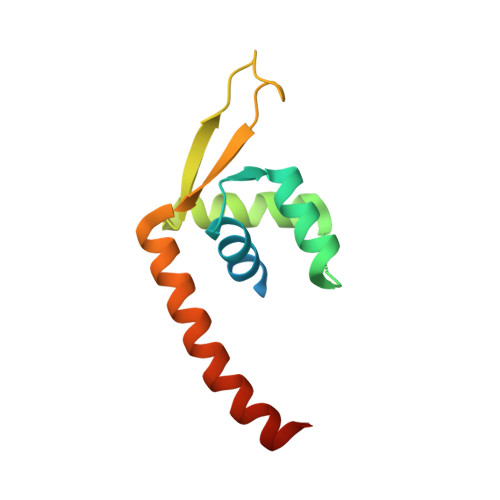Crystal structure and DNA binding activity of a PadR family transcription regulator from hypervirulent Clostridium difficile R20291.
Isom, C.E., Menon, S.K., Thomas, L.M., West, A.H., Richter-Addo, G.B., Karr, E.A.(2016) BMC Microbiol 16: 231-231
- PubMed: 27716049
- DOI: https://doi.org/10.1186/s12866-016-0850-0
- Primary Citation of Related Structures:
5DYM - PubMed Abstract:
Clostridium difficile is a spore-forming obligate anaerobe that can remain viable for extended periods, even in the presence of antibiotics, which contributes to the persistence of this bacterium as a human pathogen during host-to-host transmission and in hospital environments. We examined the structure and function of a gene product with the locus tag CDR20291_0991 (cdPadR1) as part of our broader goal aimed at elucidating transcription regulatory mechanisms involved in virulence and antibiotic resistance of the recently emergent hypervirulent C. difficile strain R20291. cdPadR1 is genomically positioned near genes that are involved in stress response and virulence. In addition, it was previously reported that cdPadR1 and a homologue from the historical C. difficile strain 630 (CD630_1154) were differentially expressed when exposed to stressors, including antibiotics. The crystal structure of cdPadR1 was determined to 1.9 Å resolution, which revealed that it belongs to the PadR-s2 subfamily of PadR transcriptional regulators. cdPadR1 binds its own promoter and other promoter regions from within the C. difficile R20291 genome. DNA binding experiments demonstrated that cdPadR1 binds a region comprised of inverted repeats and an AT-rich core with the predicted specific binding motif, GTACTAT(N 2 )ATTATA(N)AGTA, within its own promoter that is also present in 200 other regions in the C. difficile R20291 genome. Mutation of the highly conserved W in α4 of the effector binding/oligomerization domain, which is predicted to be involved in multi-drug recognition and dimerization in other PadR-s2 proteins, resulted in alterations of cdPadR1 binding to the predicted binding motif, potentially due to loss of higher order oligomerization. Our results indicate that cdPadR1 binds a region within its own promoter consisting of the binding motif GTACTAT(N 2 )ATTATA(N)AGTA and seems to associate non-specifically with longer DNA fragments in vitro, which may facilitate promoter and motif searching. This suggests that cdPadR1 acts as a transcriptional auto-regulator, binding specific sites within its own promoter, and is part of a broad gene regulatory network involved, in part, with environmental stress response, antibiotic resistance and virulence.
- Price Family Foundation Institute of Structural Biology and Department of Microbiology and Plant Biology, University of Oklahoma, 770 Van Vleet Oval, Norman, OK, 73019, USA.
Organizational Affiliation:
















